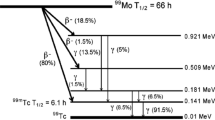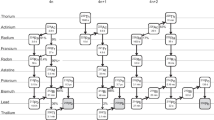Abstract
A new 99Mo production method is proposed through 99Tc (μ−, v) 99Mo muon nuclear-capture reaction with recycled 99Tc material. The 99Mo is a parent nucleus of 99mTc for imaging diagnostics. The 99Mo is produced in the 99Tc target, and the molybdate ion (MoO42−) is separated from the pertechnetate ion (99TcO4−). High 99Mo-specific activity is obtained, and no radioactive by-product is generated. The 99Tc material has an unlimited resource: it is a decay product of 99Mo and is contained in spent nuclear fuel. The 99Mo-specific activity and production activities of 99Mo and 99mTc are calculated assuming the reaction branching ratios.




Similar content being viewed by others
References
Firestone RB (1996) Table of Isotopes. CD-ROM Eighth Edition, Version 1.0
Molybdenum-99 for Medical Imaging (2016). National Academies, Science Engineering Medicine, ISBN 978-0-309-44531-3. https://doi.org/10.17226/23563, http://nap.nationalacademies.org/23563
Radioisotopes in Medicine. https://www.world-nuclear.org/information-library/non-power-nuclear-applications/radioisotopes-research/radioisotopes-in-medicine.aspx
Design principles of the 99Mo → 99mTc radionuclide generator. https://humanhealth.iaea.org/HHW/Radiopharmacy/VirRad/Eluting_the_Generator/Generator_Module/Design_principles/index.html
FACT SHEET: Encouraging Reliable Supplies of Molybdenum-99 Produced without Highly Enriched Uranium. (2012). https://obamawhitehouse.archives.gov/the-press-office/2012/06/07/fact-sheet-encouraging-reliable-supplies-molybdenum-99-produced-without-
Non-HEU Production Technologies for Molybdenum-99 and Technetium-99m. (2013) IAEA Nuclear Energy Series No. NF-T-5.4
Noorden RV (2013) Radioisotopes: The medical testing crisis. Nature 504:202–204. https://www.nature.com/news/radioisotopes-the-medical-testing-crisis-1.14325
Qaim SM, Sudár S, Scholten B, Koning AJ, Coenen HH (2014) Evaluation of excitation functions of 100Mo(p, d+pn) 99Mo and 100Mo (p,2n)99mTc reactions: Estimation of long-lived Tc-impurity and its implication on the specific activity of cyclotron-produced 99mTc. Appl Radiat Isot 85:101–113
Cyclotron-Based Production of Technetium-99m. (2017) IAEA Radioisotopes and Radiopharmaceuticals Report No.2, International Atomic Energy Agency, Vienna
Schaffer P, Bénard F, Bernstein A, Buckley K, Celler A, Cockburn N, Corsaut J, Dodd M, Economou C, Eriksson T, Frontera M, Hanemaayer V, Hook B, Klug J, Kovacs M, Prato FS, McDiarmid S, Rutha TJ, Shanks C, Valliant JF, Zeisler S, Zetterberg U, Zavodszky PA (2015) Direct production of 99mTc via 100Mo (p,2n) on small medical cyclotrons. Phys Procedia 66:383–395
Minato F, Tsukada K, Sato N, Watanabe S, Saeki H, Kawabata M, Hashimoto S, Nagai Y (2017) Measurement and Estimation of the 99Mo Production Yield by 100Mo(n,2n)99Mo. J Phys Soc Jpn 86:114803
Matsuzaki T, Sakurai H (2017) Method for preparing radioactive substance through Muon irradiation, and substance prepared using Said Method. Patent WO2017135196A1
Measday DF (2001) The nuclear physics of muon capture. Phys Rep 354:243–409
Backenstoss G, Charalambus S, Daniel H, Hamilton WD, Lynen U, Malsburg Ch von der, Poelz G, Povel HP (1971) Nuclear γ-rays following Muon capture. Nucl.Phys Al62:541–551
Matsuzaki T, Ishida K, Nagamine K, Watanabe I, Eaton GH, Williams WG (2001) The RIKEN-RAL pulsed Muon facility. Nucl Instrum Method Phys A465:365–383
The Paul Scherrer Institute, The PSI proton accelerator. https://www.psi.ch/media/the-psi-proton-accelerator
TRIUMF, Main Cyclotron & Beam Lines. https://www.triumf.ca/research-program/research-facilities/main-cyclotron-beam-lines
Rutherford Appleton Laboratory, ISIS Neutron and Muon Source. https://stfc.ukri.org/research/our-science-facilities/isis-neutron-and-muon-source/
J-PARC, Materials and Life Science Experimental Facility. https://j-parc.jp/c/en/facilities/mlf/index.html
Ando Y, Takano H (1999) Estimation of LWR Spent Fuel Composition. JAERI-Research 99–004
Morita Y, Mizoguchi K, Yamaguchi I, Fujiwara T and Kubota M (1998) Development of Partitioning Method: Confirmation of Behavior of Technetium in 4-Group Partitioning Process by a Small-Scale Experiment. Japan Atomic Energy Research Institute (in Japanese). https://jopss.jaea.go.jp/search/servlet/search?2006188
Fricke G, Bernhardt C, Heilig K, Schaller LA, Schellenberg L, Shera EB, De Jager CW (1995) Nuclear ground state charge radii from electromagnetic interactions. At Data Nucl Data Tables 60:177–285
Statistics on the Distribution of Radioisotopes in Japan (2023) Radioisotopes 72:49–100. https://doi.org/10.3769/radioisotopes.72.49
Reduction and Resource Recycling of High-level Radioactive Wastes through Nuclear Transmutation. http://www.jst.go.jp/impact/en/program08.html
Acknowledgements
A part of the research was funded by the ImPACT Program of the Council for Science, Technology, and Innovation (Cabinet Office, Government of Japan) [24].
Author information
Authors and Affiliations
Corresponding author
Ethics declarations
Conflict of interest
The authors declare that they have no conflict of interest.
Additional information
Publisher's Note
Springer Nature remains neutral with regard to jurisdictional claims in published maps and institutional affiliations.
Rights and permissions
Springer Nature or its licensor (e.g. a society or other partner) holds exclusive rights to this article under a publishing agreement with the author(s) or other rightsholder(s); author self-archiving of the accepted manuscript version of this article is solely governed by the terms of such publishing agreement and applicable law.
About this article
Cite this article
Matsuzaki, T., Sakurai, H. 99Mo production via 99Tc (μ−, ν) 99Mo reaction with recycled 99Tc. J Radioanal Nucl Chem (2024). https://doi.org/10.1007/s10967-024-09418-5
Received:
Accepted:
Published:
DOI: https://doi.org/10.1007/s10967-024-09418-5




